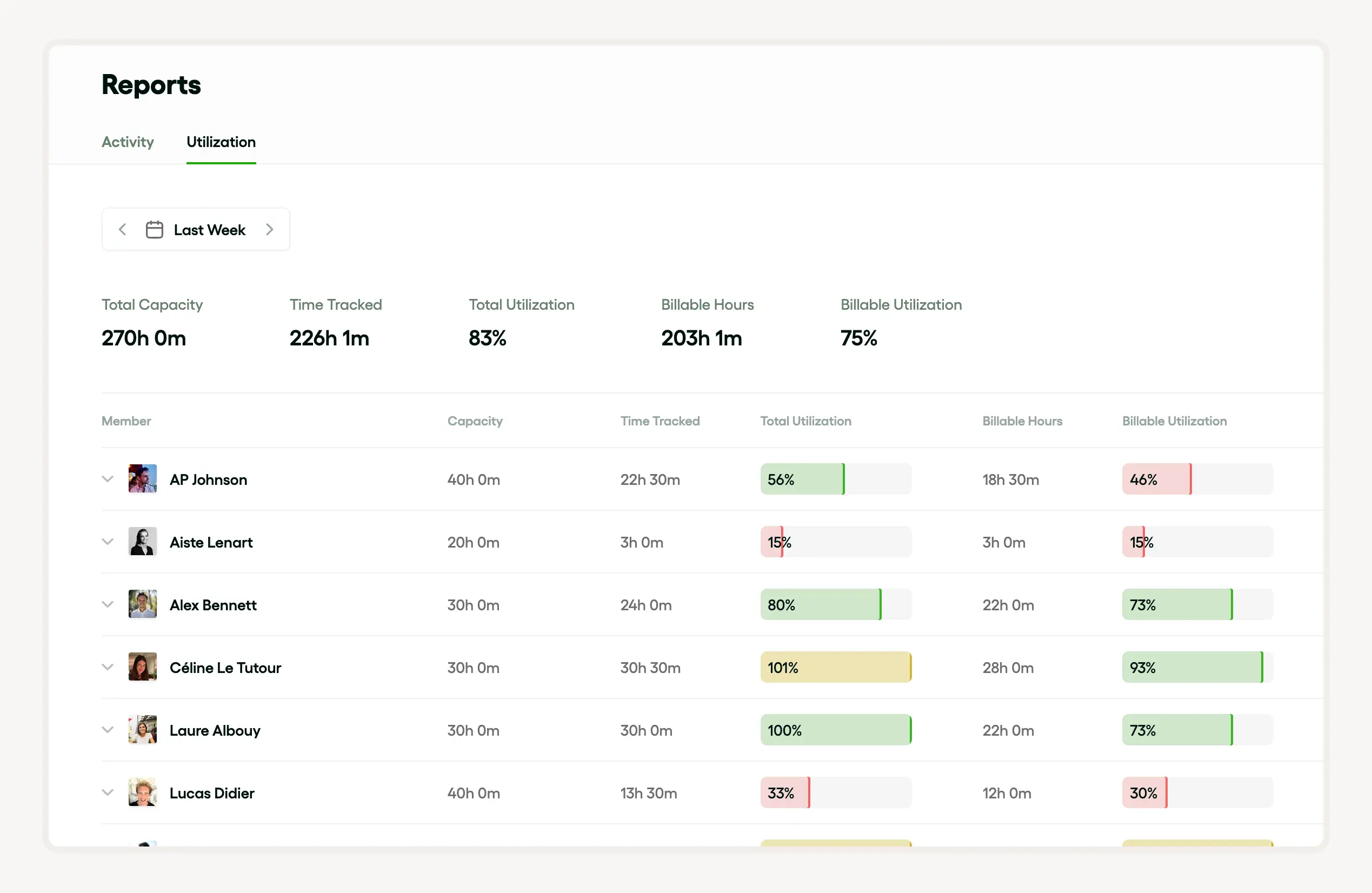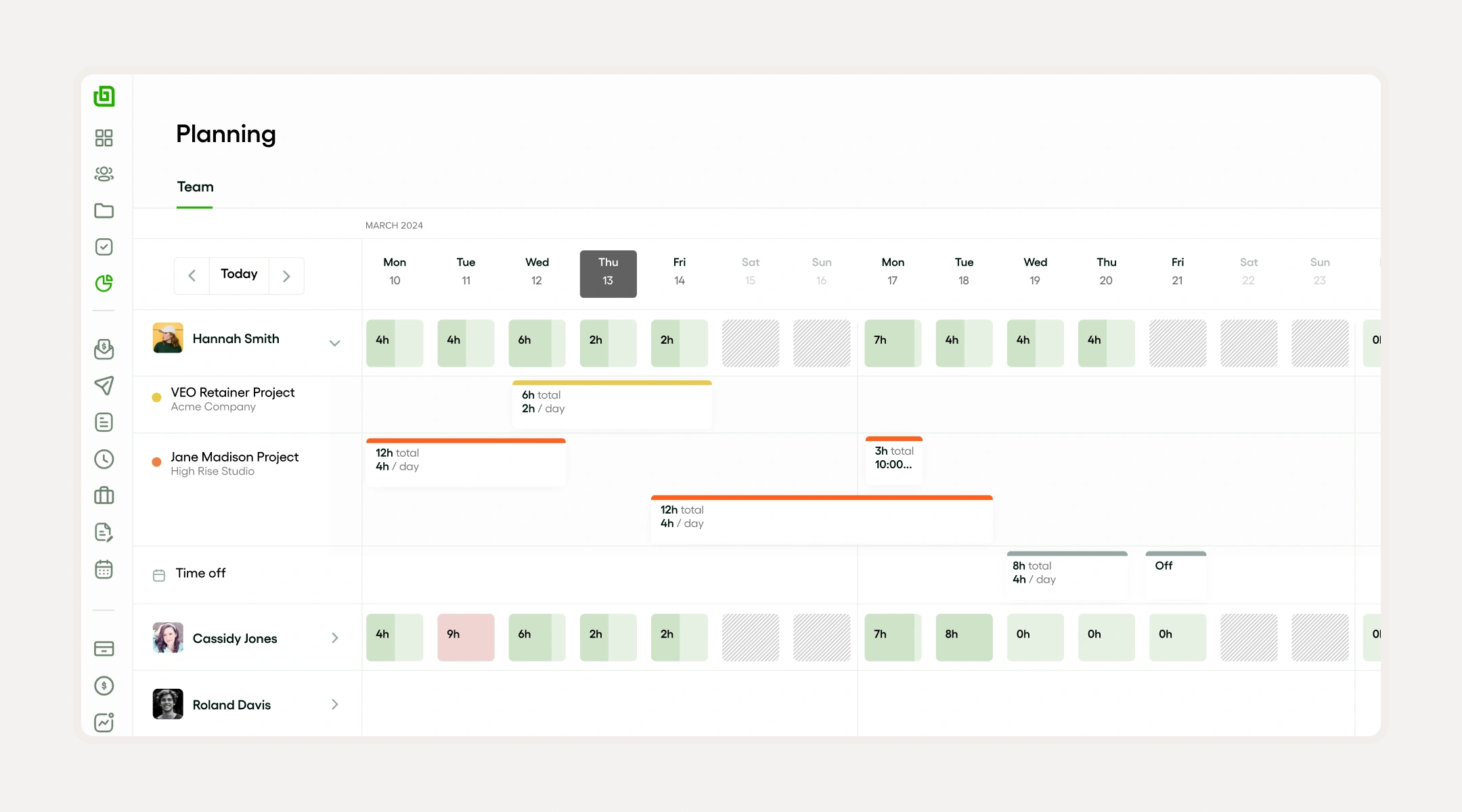The utilization rate is a critical metric that helps assess the effective use of resources. It is a great way to measure productivity and is necessary to improve resource management. The utilization rate is key in many fields. It shows how much a business uses what it can do. This rate, also called capacity utilization rate, tells us how well a company works. It can show how resources, time, or goals are used.
What is a utilization rate?
Utilization rate is a metric that shows the percentage of an employee or team's total hours spent on billable work on the total available working hours. It can be calculated at the company level, or at the employee level. It helps see if each team member is productive enough and enough of its time is spent on billable work.
There are two types of utilization rates:
- Billable utilization: helps to monitor the share of hours worked on billable tasks
- Resource utilization: gives an overall view of the total hours worked on the total available working hours
How to monitor utilization rate?
Why monitoring utilization rate is important?
The utilization rate is important for seeing if a business is doing well. This number shows if a company is using what it has to make money. The best rate means more profit. A high rate means good use of what a company owns, which means more money. For businesses that charge for time, how much work is for clients is key. Monitoring utilization rate will help any business to:
- Balance workloads across team members and improve team efficiency
- Make sure no resources are wasted
- Determine appropriate billing rates
- Ensure client are billed the exact number of hours worked
- Increase profitability
How to calculate utilization rate?
Utilization rate is a metric that quantifies the proportion of used capacity to total available capacity. It’s calculated by dividing the used capacity by the total available capacity and multiplying by 100 to get a percentage. This is the fundamental formula for utilization.
.png)
Quickly calculate your employee utilization rate (total and billable) using Bonsai's utilization calculator.
Common pitfalls in utilization rate calculation
Common errors in calculating utilization rate include neglecting to consider total available capacity, leading to overestimation or underestimation. Often, businesses overlook periods of inactivity, which skews the capacity utilization rate. Additionally, using an incorrect utilization formula can create a discrepancy between the actual and calculated utilization rate.
Other issues can arise in resource utilization calculations, where a discrepancy between billable utilization and actual utilization can occur.
Target utilization rates and optimal utilization rates might be mistakenly interchanged. The former is the goal in operations, while the latter is the highest achievable utilization ratio without causing adverse effects. Misunderstanding this difference can misrepresent the utilization calculations.
Role of utilization rate in performance management
In performance management, the utilization rate plays a vital role in determining the efficiency and capacity of resources. The utilization rate, sometimes referred to as the capacity utilization rate, is used to measure the extent to which the total available capacity of any given resource is being used effectively.
Through utilization calculations like the utilization formula or utilization ratio, performance management can deploy both target utilization rates and optimal utilization rate strategies to ensure resources are not over or under-utilized. This is crucial as it helps to streamline operations, optimize efficiency, and drive profitability.
How utilization rate affects employee performance
Utilization rate is a primary measure of employee performance. It refers to the percentage of a worker's time that is billable or contributes directly to the output of the company. High utilization rates may indicate efficiency but can also lead to burnout if sustained over time.
Target utilization rates provide a benchmark for the optimal rate at which employees should be used. This considers the total available capacity of employees and aims for a balance between resource utilization and employee wellbeing. Factors involved in obtaining a utilization ratio may also include the capacity utilization rate, utilization formula, and utilization calculations.
However, organizations should ensure utilization measures do not encourage cramming activities within employees' work hours, which could detrimentally impact quality of work. Consistent monitoring of utilization rates and adjusting them based on performance feedback is essential for maintaining productivity and employee satisfaction.
Utilization rate and business performance
Utilization rate is a critical measurement in gauging business performance. It signifies how well a company utilizes its resources and its total available capacity. A high capacity utilization rate often indicates optimal business operations, efficiency, and profitability.
However, deriving this rate involves meticulous utilization calculations, such as the billable utilization formula, to determine the utilization ratio.
Setting and achieving target utilization rates can result in enhanced productivity, increased revenue, and improved business prospects. Therefore, businesses should prioritize maintaining their optimal utilization rate for sustained success.
How to monitor utilization rate?
Closely and regularly monitor utilization rate is crucial for businesses seeking to be profitable. Various software tools can help track time and monitor the utilization rate for businesses. Features of such tools usually include the capacity to monitor resource utilization, track time, carry out utilization calculations, and set target utilization rates. They can efficiently manage total available capacity and help achieve optimal utilization rate.
Use a project management software with time tracking
With a project management tools that integrate resource management, businesses will be able to get quick view at their health and see how resources are utilized.
Tools like Bonsai provide:
- Resource allocation: allowing businesses to plan team capacity, allocating team hours and set capacity rates
- Reporting: providing real-time reports on workload and profitability, which ensures businesses to quickly course-correct and stay under budget
- Robust time-tracking: by tracking time on tasks and indicating wether it's billable or non-billable time, businesses will be able to monitor utilization
- Invoicing: all workforce management tools don't provide invoicing, but it's a real plus to ensure all billable hours are correctly billed to clients

Using Bonsai for project and resource management is essential due to its comprehensive features that cater to the core needs of project planning and execution. Bonsai offers a suite of integrated tools that cover every aspect of project management, from task assignment to financial tracking, all within a single platform.
How to improve utilization rate?
Boosting the utilization rate means looking at how we use resources and time. When we up the hours we bill for, without overworking stuff, the numbers get better. Sometimes, we need to move things around or get more.
We might automate simple tasks to do more. Changing the math we use to fit our goals can help. Keeping an eye on the numbers regularly helps us hit the targets we set.
For credit, managing how much of it we use keeps our scores healthy. We can do this by upping our limits or paying off what we owe often. This gives us more room to breathe.
1. Effective scheduling and planning
Planning well is key to using what we have best. It helps us reach the goals we set and do more with what we have. Watching the hours we can bill and other numbers is important to really understand our rate and see where we can do better.

2. Investing in employee training and development
Putting money into teaching our team is big for upping our rate and how much we do. Smart training can make our team and tools work better and team members able to handle multiple tasks.
Good training makes our team better and happier. This means they use what we have better. It helps them hit their goals and makes our whole place work best.
3. Implement performance monitoring
Businesses need to track utilization metrics regularly to identify bottlenecks. Using a tool like Bonsai can help track hours, monitor utilization and get reports on time spent on billable vs non billable work.
4. Minimize non-billable time
To increase businesses utilization rate, less time should be spent on non-billable tasks. This can be done by:
- Streamlining administrative tasks, using automation tools for tracking time and invoicing for example.
- Standardize work processes to improve efficiency and minimize unnecessary steps.
- Prioritize billable work: businesses can choose to leave non-billable time for slower periods.
- Track both billable and non-billable time: this will allow businesses to easily get reporting and insights on those hours.
- Optimize internal communication: use a project and client management tool to centralize all client details, projects and tasks in one place.
Conclusion: The impact of utilization rate on business success
In conclusion, a business's success vastly depends on the optimal utilization rate of its resources. High capacity utilization rates and efficient resource utilization play a crucial role in maximizing productivity, reducing costs, and increasing profitability. Key metrics like billable utilization, credit card utilization, and the utilization ratio act as vital indicators of a company's operational efficiency. It is therefore essential for businesses to monitor their utilization measures regularly and aim for total available capacity wherever possible to ensure long-term viability and growth.






